WORD MADE FLESH
Rex Butler
Paul Yore had them, like any number of other objects in his work, in the palm of his hand. They were surprisingly middle-aged and middle-class like me, as though young people don’t really come out to hear people speak live any more.
It was the weekend after the opening of Yore’s show WORD MADE FLESH at the Australian Centre for Contemporary Art (ACCA), and he was in conversation with Nick Henderson, a volunteer member of the Australian Queer Archives. Yore speaks assuredly and with great analytical intelligence. He’s also a contemporary style icon with his glasses, piercings and the best haircut I’ve seen on anyone in ages. (If Alpha60 ever want to replace that photo of Jean-Luc Godard at the back of their shop now that he’s passed away, they could do worse than Yore.)
Yore after about three or four questions was in full rhetorical flight, and in response to one old-school romantic—and, of course, this was especially striking given the large crowd who had turned out to see him—insisted that he was nothing more than an anonymous “cultural worker” filling a pre-existing role, effectively constrained in what he could do or say. So far, so boilerplate cultural Marxism, of the kind they used to teach at art schools (even as recently as 2010 when Yore graduated from Monash).
But then, several questions later—and I think they were all asked by men—a younger female voice piped up, nervous, a little less assured. Obviously an art student. And they wanted to know, “If you had any advice for anyone starting a career in art, what would it be?”
At which point Yore, realising that everything was different, immediately changed tone. In a softer, less authoritative, more intimate manner, he spoke quietly into his microphone, “Well, you’ve just got to find your own voice and be true to yourself”.
Yore was right, it was the only answer he could possibly give in the circumstances. Any other response would have been cruel and uncaring—imagine telling an aspiring young art student that the best they could hope for was to become a “cultural worker”—but there was obviously a contradiction. And yet this contradiction is everything that is captivating about his work. Indeed, the extraordinary thing about Yore’s work—and the finally moving thing about it too—is that he brings this contradiction to its highest pitch. There is a magnificent hysteria about his work in its self-contradiction that absolutely captures the hysteria of the self-contradiction of art and ultimately society today.
Let’s start with Yore’s method. Sewing, darning, quilting, needlework. And the back story: Yore takes it up after being hospitalised, following a nervous breakdown that leads to something of a scission within his family. It’s healing, restorative, conventionally “feminine”, undemonstrative, introspective, handicraft and not art and private and domestic and not meant for public consumption.
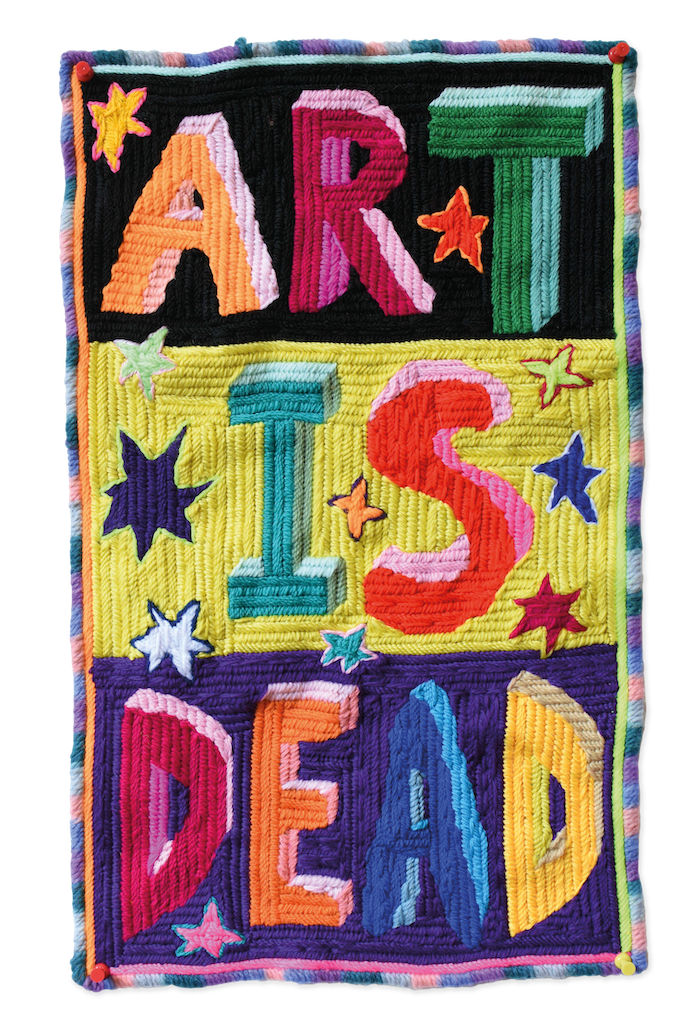
Then think what happens to it in Yore’s head: it becomes loud, declamatory, obscene. (Just think for a moment what it’s actually like reading such slogans as “Everything is Fucked”, “You’re Dead” and “See You in Hell” in needlepoint.) It’s aggressive, conventionally “macho” or “masculine”, self-assured, intolerant. (Even the irony is not quite ironic. “I’m Not Sorry” or “It’s All Wrong but Alright”: there is no real self-doubt or self-questioning here.) It is excessive and exhibitionistic, even to the extent of it not having to be read or grappled with. (This despite the artist saying in his interview with Max Delany in the catalogue that he wants to “create debate”. Who would want to start a conversation with someone who talks to them like that?) And ACCA brilliantly brought this out with their Salon-style hang, in which many of the works were hung too high to be read or even properly looked at, so that they loomed over you ominously, reminding you of all your unconscious sins and prejudices.
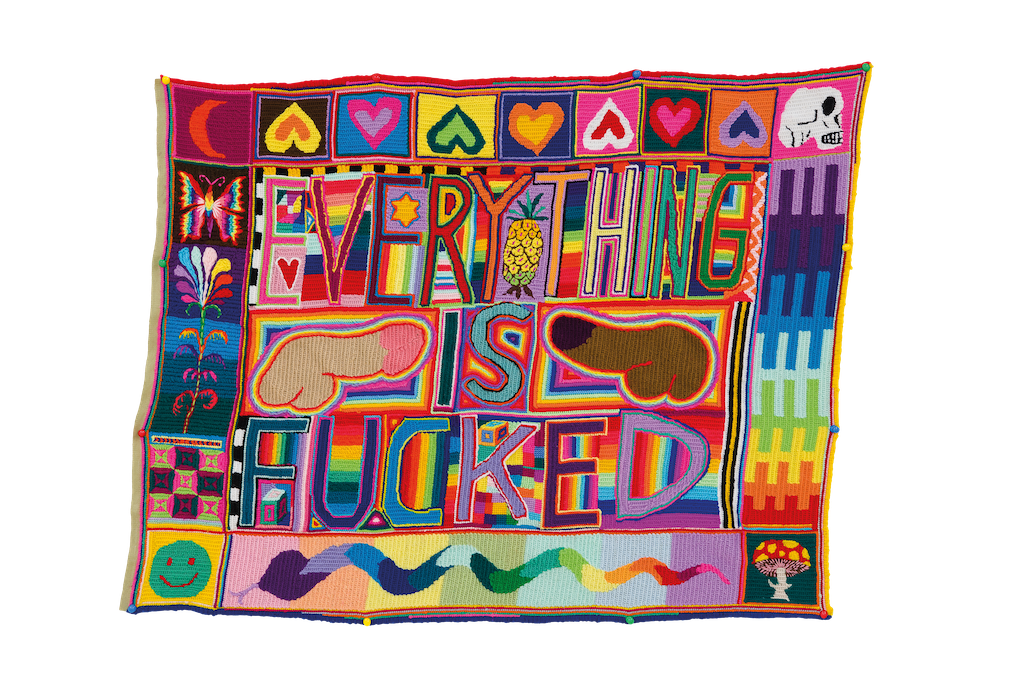
Collection of Anita & Luca Belgiorno-Nettis, Sydney.
Or even take the claim that Yore’s work is environmentally friendly with its sourcing of materials in junkshops, sorting through and recycling the detritus of society like some kind of anthropologist (the other subject Yore studied at university). Even to the extent—as I heard in a radio interview with Daniel Browning on the ABC’s The Art Show—that he likes using rugs and quilts that were previously used for cats and dogs, insofar as there is the residue of the domestic in them and even the occasional unbrushed cat fur or dog hair. It would be as though the work exists in a kind of ecological balance or even helps restore things to their natural place.
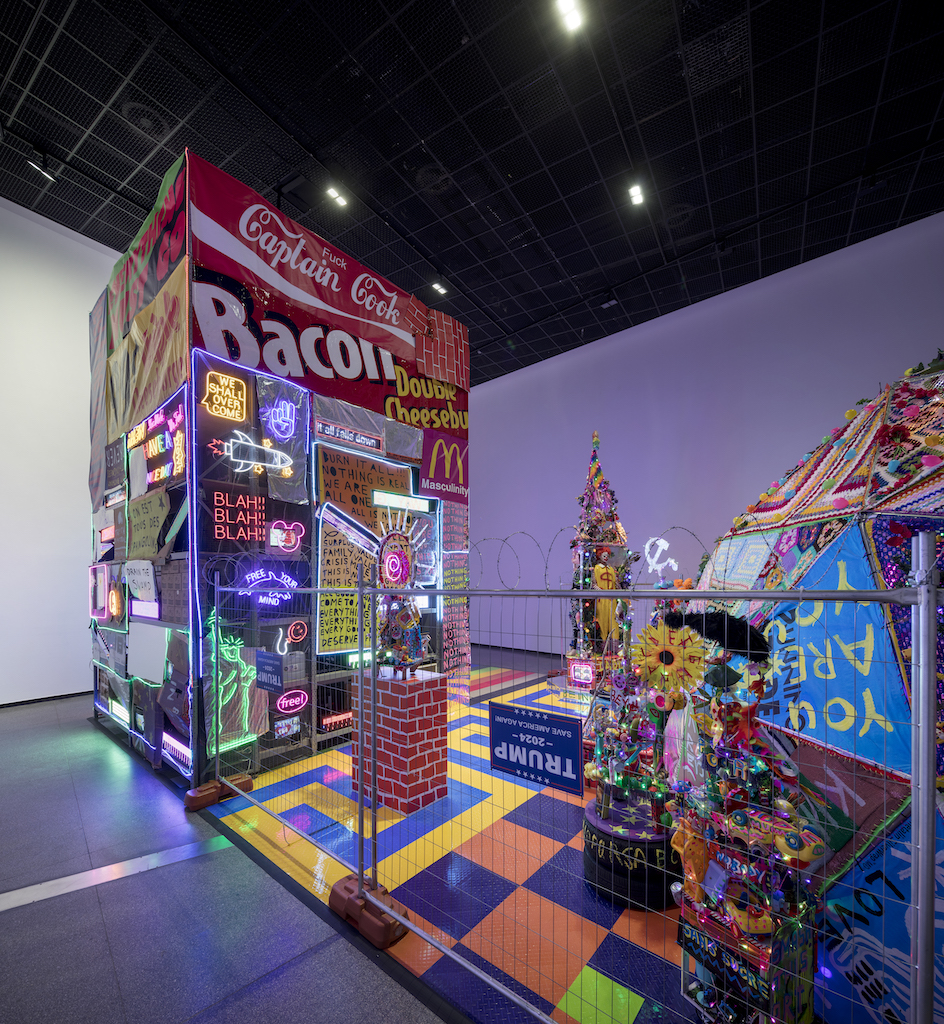
And yet we only have to go to the magnificent fairground of the final room of the ACCA show, which gives the exhibition its title, with its forbidding wire fence, Trump 2024 election placards hung upside down—more on them in a moment—the chimes that are rung by flowing water (listening to them, I kept on thinking of the slogan in an earlier room, “Drain the Swamp”), and most of all the blazing last room of the exhibition full of video monitors that reminded me of a lowrollers room in a casino or the back room of a pub where they keep the pokies. They were inserted one on top of the other in a mirrored wall and featured a Shell logo and a pig-like Donald Trump crawling on all fours along with the statement “In a world that has been turned upside down” and a yellow McDonald’s arch and Osama Bin Laden and the statement “Ideology always paves the way towards atrocity”. On the outside of this final stack were the slogans “Free Your Mind” and “Dreams Can Come True” in neon, and at the centre of a brightly painted rainbow floor there was a terrifying Ronald McDonald clown spraypainted with a dollar sign that looks for all the world like Pennywise from Stephen King’s It.
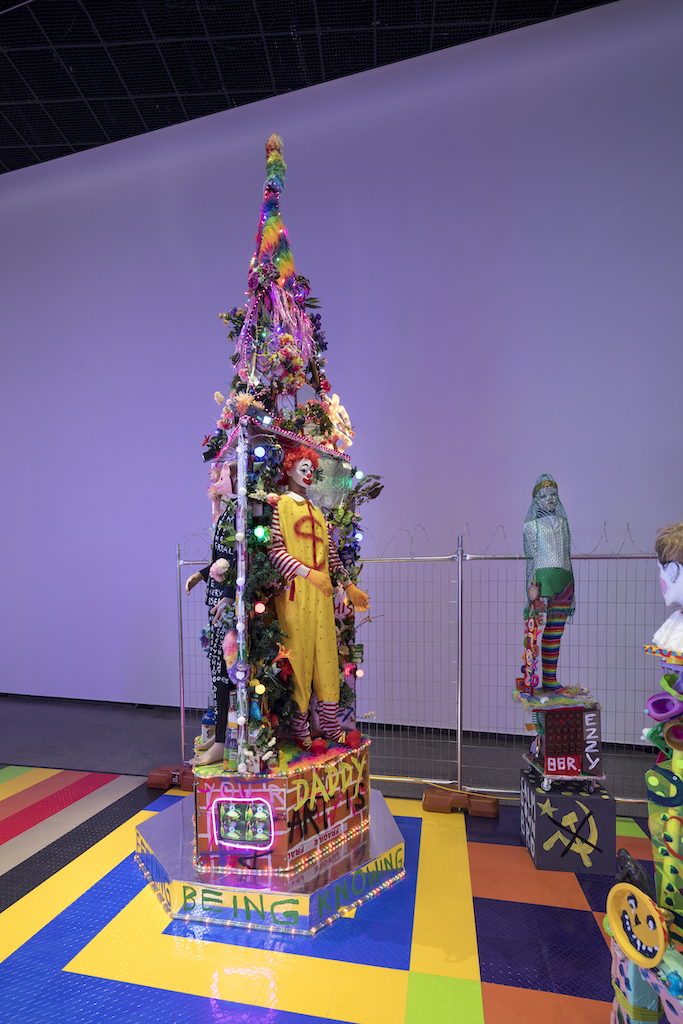
I remember tottering out of that last room overwhelmed and fatigued—I’d spent an age in there waiting for the captions of the videos to unscroll and then checking on my phone who had originally said them—and thinking that I’d just seen maybe the best work of art I’d come across in years. But eco-friendly and caring and maternal and recycling? Not quite. It’s as blaring, loud and energy unconscious as you could possibly imagine and goes against everything said to be represented by the rugs.
Yore’s work is a complete contradiction, and that I think is the point. In fact, it’s exactly the kind of contradiction spoken of when the work of art—only the most inane and uninteresting works of contemporary art—speaks about itself. This is what we have in the video that features the face of Leonardo di Caprio: “There is in fact no such thing as art for art’s sake, art that stands above classes, art that is detached from or independent of politics”. And this is what we have in the video in which we have one man fellating another in a gay porn movie: “It seems that art as art expresses a truth, an experience, a necessity which, although not in the domain of radical praxis, are nevertheless components of revolution”.
This sort of self-critique is usually so inane because the particular work of art proposing it sees it as applying to art in general but not to itself. There is a kind of bad faith, a self-exculpating irony, in which the work excuses itself from the condition it analyses. But in Yore’s case the contradiction, the self-contradiction, is so exuberantly embraced, admitted to and dramatised—exhaustively and exhaustingly—that it becomes something else. It becomes genuinely revealing of our society in its very inability to remain in control of its contradictions. It becomes finally unself-conscious in its absolute self-consciousness.
This is the final tone of Yore’s work: defiantly and wilfully unself-conscious, arguing with itself, tearing itself apart and stitching itself together again. Yore lambasts right-wing conservatism and its censoriousness, homophobia, racism and colonialism, but he also reacts negatively against those who think that they (and art) simply stand against this, judging it from the outside, as though it does not involve them and does not in a way speak of them. This is Yore again in his interview with Delany: “In some respects, I would say my work reacts against both the outright idiocy of the right, and the self-protective judgement of liberal elites in institutional and academic circles”.
But, again, this criticism is not made from the outside because Yore would acknowledge that he himself embodies both attitudes at various times. It is precisely to repeat the problem to believe that one can stand outside of it. And this shouting at himself—it is Yore, after all, who is the true addressee of those quilted works in the first several rooms, “Say No To Plastic Fags”, “Shove It Up Your Ass” and “I’m with Stupid”—rises to a gradual climax. All of which is embodied in all of those phalluses scattered throughout Yore’s work, which are as much as anything like wagging fingers lecturing you, before they explode—sorry, ejaculate—in frustration when they rub themselves up the wrong way.
All of which leaves a nasty stain to be mopped up, which is where the critic comes in.
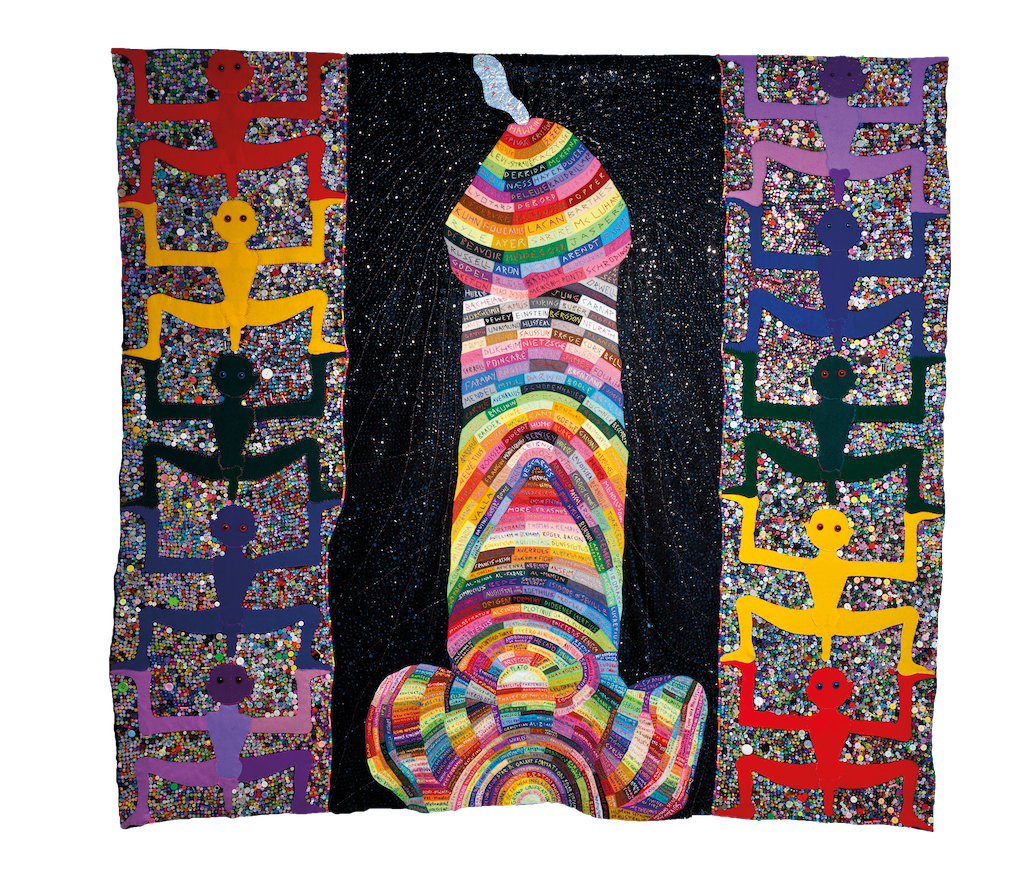
Except that, as Yore cautions us again and again, let us not think that art—or the art critic—has the answers. All we can effectively do is call out each other’s misunderstandings. And all art can do is to bring the contradictions of our society to a climax. We perhaps get something of this in those two big phalluses in the show: the big needlework appliqué This Moment is Critical (2014) and the large soft sculpture Mummy (2018). In the first we have a whole series of scientists’ and philosophers’ names, starting at the top with “Hawking”, and then running down “Spivak”, “Kristeva”, “Žižek”, “Baudrillard” and so on. In the second, we again have a series of great artists’ and philosophers’ names, “Marx”, “Hume” and “Picasso”, but mixed up with a series of other objects and issues, “debt”, “Belarus” and “Authoritarianism”. Now it might be thought that Yore puts in all of those philosophers’ names because he likes them—and if so, well read—but it’s really an irreconcilable cacophony. How are we really to put together, for example the cool nihilism of Baudrillard and the restless activism of Slavoj Žižek? Equally, in the second work, there is really no meaningful connection we can make between the names and the urgent matters seemingly evoked. And, in both cases, this is just the point: there is no possible consensus or agreement, just irreconcilable difference and contradiction with Yore being unable to impose any overall preference or system. Indeed, in 2016 Yore made a series of appliqués, not in the show, entitled ART IS NATURE, ART IS THEFT, ART IS LANGUAGE, ART IS FREEDOM and ART IS PORNOGRAPHY, again allowing all of these irreconcilable alternatives to co-exist.
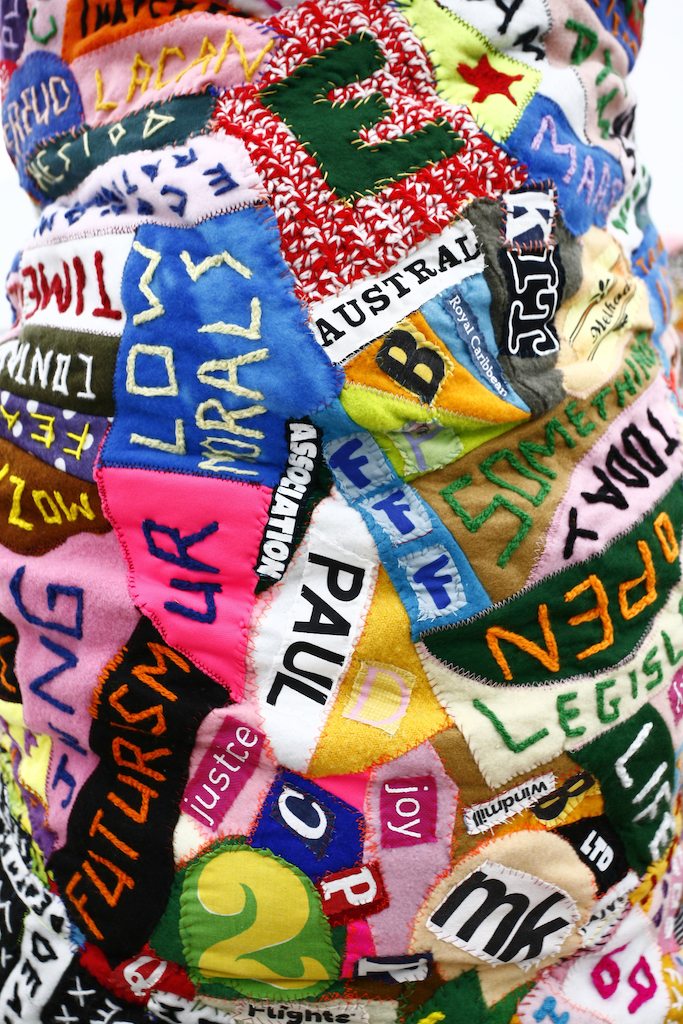
203.0 x 51.0 x 49.0 cm. Collection of Michael Schwarz and David Clouston, Melbourne.
At the moment climate protestors are gluing themselves to works of art or throwing cans of tomato soup at them, and in the not so distant future we predict they will actually start destroying them. But we would want to suggest that Yore’s work already does destroy itself in the name of a higher cause, or at least rips itself in two. Or even—and we think that this is undoubtedly the next step for artists in all of this—it as it were glues itself onto the protestor gluing itself onto it. That is to say, if I was a political artist, the next work I’d come up with is me gluing myself onto protestors gluing themselves onto a work of art and claiming their protest as a work of art. And Yore’s work is both of these: both the attempt to destroy art and the unavoidable remarking of this from the privileged point of view of art—and again this is its irresolvable contradiction, as though we could imagine an endless trail of protestors gluing themselves to the artist who glued themselves to the protestors…
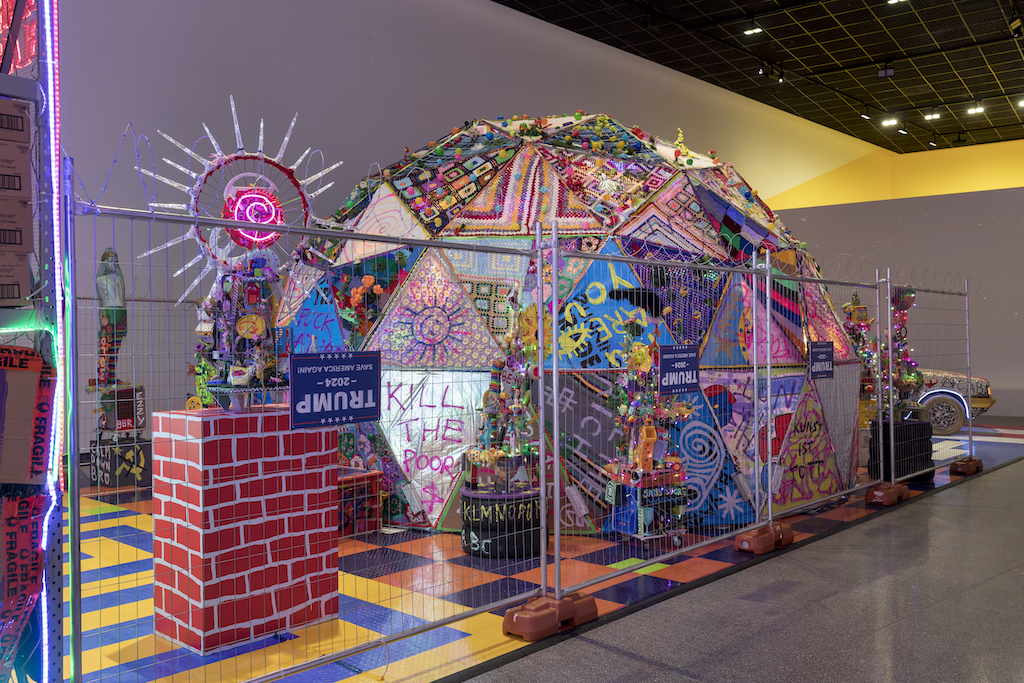
But to go back to conclude to those upside-down placards for Trump’s proposed run for President in 2024 that hang from the fence in the last room of WORD MADE FLESH. The point here would be that, for all of the apparent choice of democracy, there is no fundamental choice or only a certain forced choice. We might think we unelect Trump and he is back again, or the candidate we elect is really no different from Trump (hence Žižek’s controversial advice to vote for Trump over Hilary Clinton). Opposites co-exist or cannot be chosen between, which proves that they are not real opposites but produce and require each other. Yore both saying that artists are “cultural workers” and telling that student to “find her own voice” reveals that these are not authentic choices but imply each other. The presumptions of one contaminate its notional alternative. So that you do not become a cultural worker without thinking you are finding your own voice and you do not find your own voice without becoming a cultural worker. But Yore in pushing both possibilities to their limit perhaps allows us to think that unchosen choice, what cannot be chosen in our society as it stands (or at least allows us to think why we cannot choose it). Yore is indeed hoping that the word is made flesh, that in thinking things or even their impossibility he in some way makes them possible. Maybe the power is in our hands or at least hand.
Rex Butler teaches Art History in the Faculty of Art Design and Architecture at Monash University.


